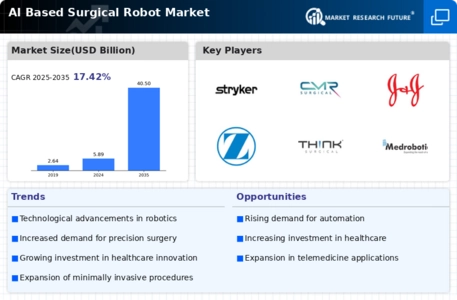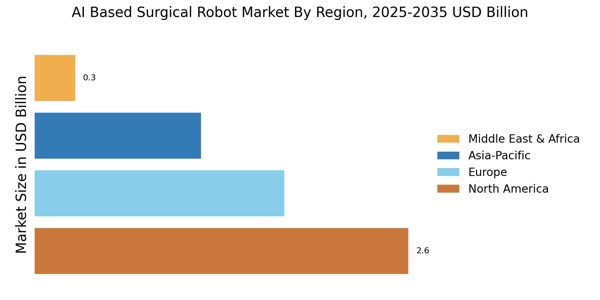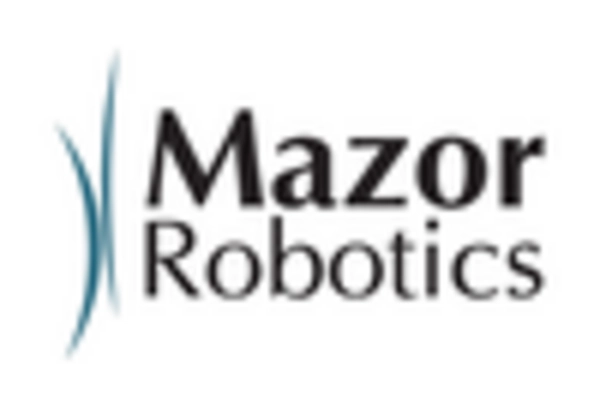Technological Innovations in Robotics
Technological advancements in robotics are significantly influencing the AI Based Surgical Robot Market. Innovations such as enhanced imaging systems, improved haptic feedback, and artificial intelligence algorithms are transforming surgical practices. These technologies enable surgeons to perform complex procedures with greater accuracy and control. For instance, the integration of machine learning algorithms allows for real-time data analysis during surgeries, which can lead to better patient outcomes. The market for surgical robots is expected to reach USD 20 billion by 2026, driven by these technological innovations. As hospitals seek to adopt cutting-edge solutions, the demand for AI-based surgical robots is likely to surge, reflecting the industry's commitment to improving surgical efficacy.
Regulatory Support and Standardization
Regulatory support and the establishment of standardized protocols are essential drivers for the AI Based Surgical Robot Market. As the technology matures, regulatory bodies are increasingly providing guidelines that facilitate the safe and effective use of surgical robots. This regulatory framework not only ensures patient safety but also encourages manufacturers to innovate and improve their products. The approval of new robotic systems by regulatory agencies is expected to increase, thereby expanding market opportunities. Furthermore, standardization in training and operational procedures for surgical robots is likely to enhance their adoption across various healthcare settings. This supportive regulatory environment is crucial for the sustained growth of the AI-based surgical robot market.
Increased Focus on Patient Safety and Outcomes
The emphasis on patient safety and improved surgical outcomes is a driving force in the AI Based Surgical Robot Market. As healthcare providers strive to enhance the quality of care, the adoption of robotic-assisted surgeries is becoming more prevalent. These systems are designed to minimize human error and improve precision during operations, which can lead to better patient outcomes. Research indicates that robotic surgeries can reduce complication rates by up to 30%, making them an attractive option for hospitals. Consequently, the focus on patient safety is likely to propel the demand for AI-based surgical robots, as healthcare institutions prioritize technologies that enhance surgical performance and patient satisfaction.
Growing Investment in Healthcare Infrastructure
The expansion of healthcare infrastructure is a crucial driver for the AI Based Surgical Robot Market. Governments and private entities are increasingly investing in healthcare facilities to enhance service delivery and patient care. This investment often includes the procurement of advanced surgical technologies, including AI-based robotic systems. For example, many countries are allocating substantial budgets to upgrade their surgical departments, which is expected to boost the adoption of robotic-assisted surgeries. The healthcare infrastructure market is anticipated to grow significantly, with estimates suggesting an increase of over 7% annually. This growth indicates a favorable environment for the proliferation of AI-based surgical robots, as healthcare providers seek to modernize their surgical capabilities.
Rising Demand for Minimally Invasive Procedures
The increasing preference for minimally invasive surgical techniques is a pivotal driver in the AI Based Surgical Robot Market. These procedures typically result in reduced recovery times, less postoperative pain, and minimal scarring, which are appealing to both patients and healthcare providers. As a result, hospitals and surgical centers are increasingly investing in advanced robotic systems that facilitate such procedures. According to recent data, the market for minimally invasive surgeries is projected to grow at a compound annual growth rate of approximately 10% over the next few years. This trend underscores the necessity for AI-based surgical robots that enhance precision and efficiency, thereby aligning with the evolving demands of modern healthcare.


















Leave a Comment